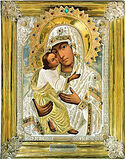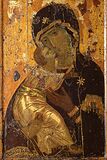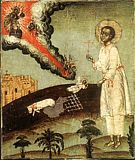 Meeting of the Vladimir Icon of the Most Holy Theotokos (1480).
Meeting of the Vladimir Icon of the Most Holy Theotokos (1480).  Martyr Agrippina of Rome and her companions Paula, Bassa, and Agathonica (253-259).
Martyr Agrippina of Rome and her companions Paula, Bassa, and Agathonica (253-259).  Synaxis of the Saints of Vladimir.
Synaxis of the Saints of Vladimir.
Martyrs Eustochius, Gaius, Proba, Lollia, and Urban, of Ancyra (4th c.). Second translation of the relics of St. Herman, archbishop of Kazan (1714). St. Artemius of Verkola (1545). Translation of the relics of St. Michael of Klops Monastery (Novgorod), fool-for-Christ (1482). St. Dionysius of Polotsk (1182). Sts. Vladimir and Agrippina, prince and princess of Rzhevsk (ca. 1226). Sts. Joseph, founder (1612), Anthony, and Ioannicius, abbots, of Zaonikiev Monastery, Vologda (17th c.).
New Hieromartyr Alexander Miropolsky, archpriest, of Kaslinsky Zavod (Ekaterinburg) (1918). New Hieromartyr Mitrophan (Krasnopolsky), archbishop of Astrakhan (1919).
Icons of the Most Holy Theotokos: “Umileniye” (“Of Tender Feeling”) of Pskov (1524), and “Zaonikiev.” (1588)
St. Etheldreda, foundress of Ely Monastery (England) (679). St. Nicetas of Thebes in Boetia and his disciples Theodore, Gregory, and Daniel (1079). Hieromartyrs Aristocleus, priest, Demetrian, deacon, and Athanasius, reader, at Salamis on Cyprus (306). Synaxis of the New Martyrs of Crete (1821-1822).
Repose of Schemamonk Zosimas of Solovki (1855) and Ivan M. Kontzevitch, spiritual writer (1965).
Wednesday. [Rom. 11:2-12; Matt. 11:20-26]
The Lord showed many signs in
Capernaum, Bethsaida and Chorazin; yet the number of those
who believed did not correspond to the power of the signs.
That is why He severely denounced these cities and
sentenced them: in the Day of Judgment it shall be more
tolerable for Tyre and Sidon, Sodom and Gomorrah, than for
these cities. We need to judge ourselves according to such
a model. How many signs has the Lord shown to Russia,
saving it from the most powerful enemies and subduing
peoples to it! How many treasures has He granted it,
pouring out unceasing signs—in the holy relics and
miracle-working icons scattered throughout all of Russia!
And yet in our days Russians are starting to turn aside
from the faith: one group is falling into total unbelief,
another group is falling away into Protestantism, a third
group is secretly weaving their own beliefs, thinking to
combine spiritism and theological ravings with Divine
Revelation. Evil is growing; evil beliefs and unbelief are
raising their head, while faith and Orthodoxy are
weakening. Will we not come to our senses? … We
will end up like the French, for instance, or
others.… But if that happens, how do you think it
will be for us on the judgment day, after God has shown so
many mercies to us? O Lord! Have mercy and save Orthodox
Rus’ from Thy just and righteous threatening!
Thursday. [Rom. 11:13-24; Matt. 11:27-30]
Come unto Me, all ye that labor and
are heavy laden, and I will give you rest. O divine, O
dear, O sweetest voice of Thine! Let us all follow the
Lord Who calls us! But first we must feel something
difficult and burdensome for us. We must feel that we have
many sins, and that these sins are grave. From this
feeling is born the need to seek relief. Faith will then
show us that our only refuge is in the Lord and Saviour,
and our steps will direct themselves toward Him. A soul
desiring to be saved from sins knows what to say to the
Lord: “Take my heavy, sinful burden from me; and I
will take on Thy easy yoke.” And it happens like
this: the Lord forgives the sins, and the soul begins to
walk in His commandments. The commandments are the yoke,
and sins are the burden. But comparing the two, the soul
finds that the yoke of the commandments is light as a
feather, while the burden of sins is heavy as a mountain.
Let us not fear readily accepting the Lord’s easy
yoke and His light burden. In no other way can we find
rest unto our souls.


![]() Meeting of the Vladimir Icon of the Most Holy Theotokos (1480).
Meeting of the Vladimir Icon of the Most Holy Theotokos (1480). ![]() Martyr Agrippina of Rome and her companions Paula, Bassa, and Agathonica (253-259).
Martyr Agrippina of Rome and her companions Paula, Bassa, and Agathonica (253-259). ![]() Synaxis of the Saints of Vladimir.
Synaxis of the Saints of Vladimir. 


















